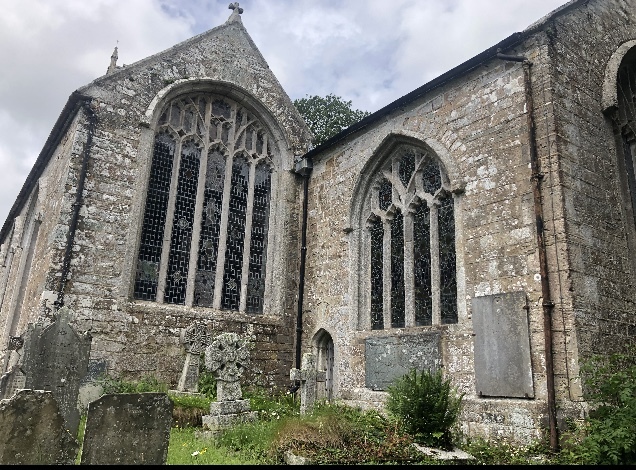
St Kew parish has the unusual distinction of being featured in the earliest saint’s life to survive for Cornwall. Crossing from Wales to Brittany in the 6th century, St Samson visited an unruly monastery in this parish dedicated to St Docco.
This was the original dedication of the parish church and Docco’s cult extended from Llandough and Llandochau in Wales, to St. Doac in Brittany. The ogham stone with the name IUSTI in a cartouche is another indicator of the antiquity of this site.
St Kew, who is first noted in c.962, eventually became the patron saint until St James was adopted in the 19th century. In 974, St Kew was conveyed to Plympton priory “for the support of two canons”. There was a chapel in this churchyard dedicated to St. Kew, remains being still evident in 1745 and also a holy well in the vicarage garden.
In 1283 the first vicar was Reymond de Landoho and in 1373 blood was shed in the churchyard though no details are given. The church is built in perpendicular style and was supported by a store or fabric fund like most others, and in addition there were at least three guilds. Building work was paid for or repaired by Pentires, Beres, Arundells, Cavells, Carnsews, Huttons, Wests, Lobbs, and Vivians amongst others. Compared to St Endellion, the nave is high, and aisle capitals are carved from Pentewan stone. The wagon roof has original beams and carved angels at the foot of each principal beam, but rather unsightly later boarding. The Victorian screen incorporates a small part of earlier work and the surviving newel staircase once led to a rood loft, from which the veil would be suspended at Eastertide over statues of Christ crucified (the rood), his mother Mary and disciple John. One of the glories of St Kew church is the medieval glass in its windows, second only to St Neot. The glass for one window was certainly bought in 1469 second-hand at Bodmin. Possibly this included the tree of Jesse still to be seen in the South East window. The east window of the north chapel dates to c.1490 and was given by the Pentire and Bere families of St Kew. It tells the story of Christ’s Passion and is of high quality and may have been made in Exeter.
Arranged in scenes, like a comic book, the Passion is explained in English, rather than Latin, below. One of the Victorian windows depicts four saints, including St. Kew with the boar and St.James with his scallop shell. It was erected in the time of the Revd. Nicholas Thomas, who was vicar here for over sixty years (1851- 1916) and travelled on horseback through the parish with his bulldog.
He also installed the organ in 1903, and was so concerned about the lack of leisure facilities for the young men that he had a meeting place built. The pulpit is believed to be Jacobean and oak pews were restored in Victorian times with the loss of most, but not all, of the original bench ends. Around the walls and floor are memorials and an old plough rests in the church of this mainly agricultural parish. In the 18th century, there was some silver and lead mining in the parish. A Lantern cross head of Catacleuse stone now in the church was found at Skisdon, a nearby manor.
Another similar type of cross from St Kew is in St. Neot’s churchyard, while a third, now in the churchyard, was used as a bridge at Polrode Mill (about three miles to the east) and erected here in 1908. On examination of the tower we see the shaft of yet another cross, possibly from the original churchyard cross. A treasure of the church less well-known than the windows is the ‘Ringers Rhyme’ board dated 1783. There were four bells in 1552; recast in 1760 to make six, and recast again in 1813. Most of the present ringers belong to old St.Kew families; one of the ringers being the present owner of Lanow.
The headline co ordinates take you to an obelisk shape from where you need the following details to find the cache .
Second digit of Dorothy Gladys age equals A
First digit in October equals B
Second digit in October equals C
CHECKSUM : ABC equals 8
The cache can be found at N50°33.A B C W004° 48.B A A
****************** ********************
For full information on how you can expand the Church Micro series by sadexploration please read the Place your own Church Micro page before you contact him at churchmicro.co.uk
See also the Church Micro Statistics and Home pages for further information about the series.
****************** *******************